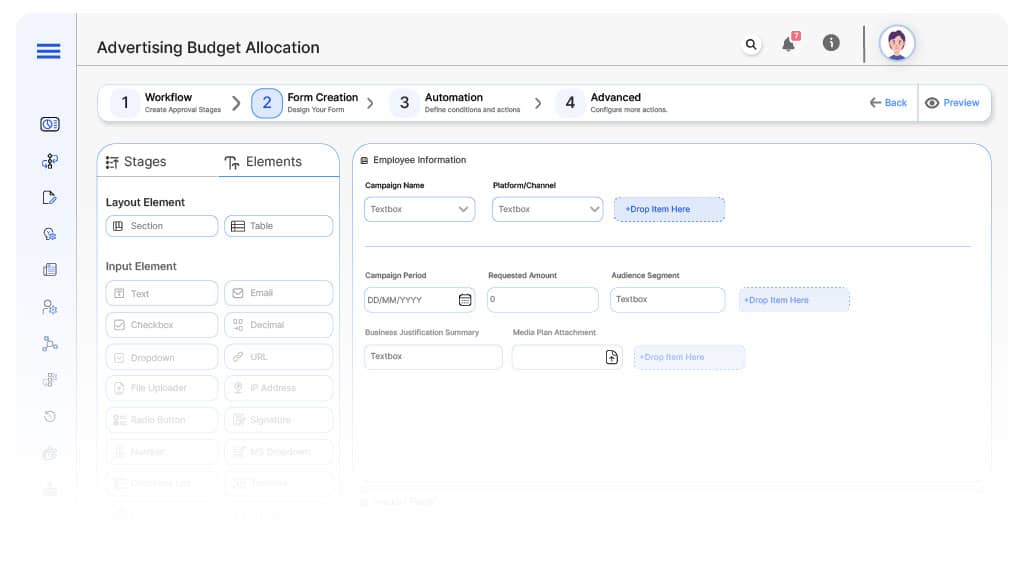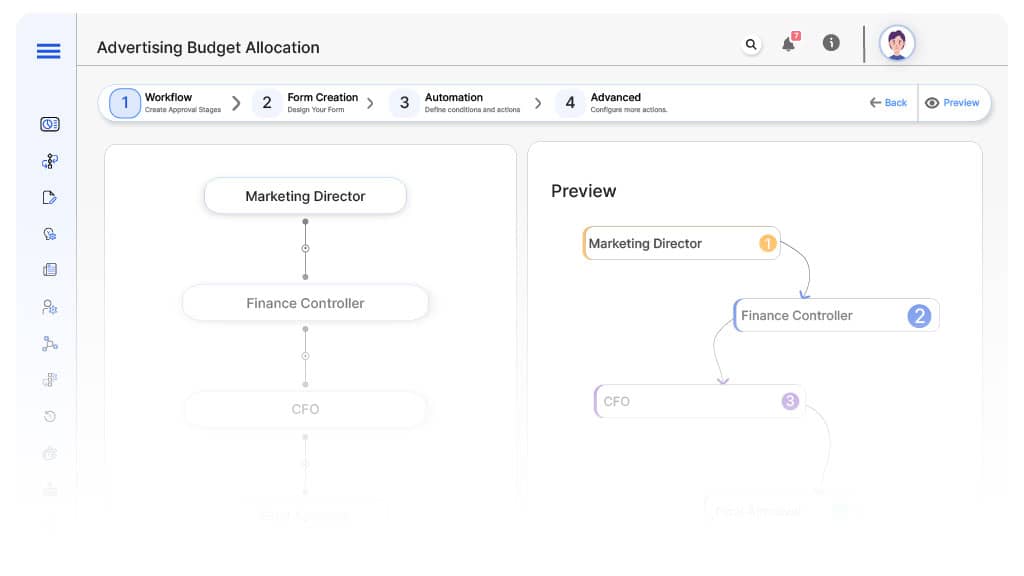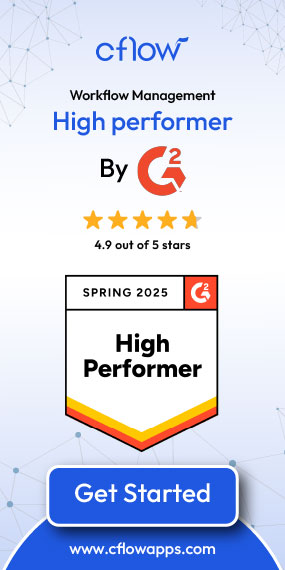- Cflow
- Advertising Budget Allocation Automation
Advertising Budget Allocation Automation
Learn how Cflow streamlines Advertising Budget Allocation Process for marketing, finance, and leadership teams, step-by-step workflow, roles, form fields, approval logic, and real examples.

Clow Team

Marketing campaign approvals ensure brand consistency, regulatory compliance, and effective budget utilization. When handled manually, campaign approvals often lead to delays, inconsistent messaging, missed deadlines, and budget overruns. Recent industry research shows that 62% of companies experience campaign delays due to fragmented approval workflows.
Without automation, marketing, compliance, legal, finance, and leadership teams struggle to coordinate messaging, creative reviews, vendor approvals, and cross-department sign-offs. This guide walks you through exactly how Cflow automates Marketing Campaign Approval Process, from campaign request to launch clearance.
What Is Advertising Budget Allocation Process?
The Advertising Budget Allocation Process governs how marketing teams request, review, approve, and receive budget assignments for advertising across digital, print, broadcast, and social channels.
Think of advertising budgets like dynamic investment portfolios , every allocation requires media planning, financial validation, leadership review, and ongoing ROI monitoring before funds are committed.
Recent industry research shows that automating advertising budget allocation improves spend control by 50% and accelerates campaign launch timelines by 40%.
Why Advertising Budget Allocations Matter for Organizations
ROI Optimization
Ensures ad spend is aligned with revenue-driving channels and audience segments.
Spending Control
Prevents budget overruns while maximizing campaign effectiveness.
Cross-Platform Visibility
Enables leadership to balance digital and traditional media investments.
Audit Readiness
Captures full approval history for financial compliance and marketing reviews.
Cross-Functional Alignment
Involves stakeholders across departments for full visibility.
Key Benefits of Automating Advertising Budget Allocation with Cflow
- Centralized Advertising Budget Portal : Cflow allows marketing managers to submit budget requests by campaign, platform, audience, and period into a unified system for finance and leadership visibility.
- Dynamic Routing Based on Campaign Size : Cflow applies routing rules based on request amount, media type, strategic importance, and brand priorities to ensure proper reviewers are involved.
- Multi-Level Approval Workflows : Requests route through marketing leadership, finance controllers, CFOs, and executives depending on spend size and revenue targets.
- Real-Time Notifications & Escalations : Automated alerts ensure timely approvals, while escalation rules prevent missed campaign launch windows.
- Document Collection & Forecast Validation : Cflow allows supporting documents like media plans, audience reports, and previous campaign performance data to be attached for finance review.
- Full Audit Trail & Budget Logs : Every request, revision, approval, and allocation decision is archived for audit-ready transparency and marketing analytics.
- Mobile Accessibility : Marketing VPs, finance teams, and executives can review, approve, and track advertising budgets remotely to avoid delays in fast-moving media cycles.
User Roles & Permissions
Marketing Manager (Initiator)
- Responsibilities: Submit advertising budget request by campaign, channel, spend category, and forecast.
- Cflow Permission Level: Submit Form.
- Mapping: “Marketing Team” group.
Marketing Director
- Responsibilities: Review media plan alignment with brand goals and campaign objectives.
- Cflow Permission Level: Approve/Reject.
- Mapping: “Marketing Leadership” group.
Finance Controller
- Responsibilities: Validate budget availability, forecast accuracy, and funding allocation.
- Cflow Permission Level: Approve/Reject.
- Mapping: “Finance Team” group.
CFO
- Responsibilities: Approve consolidated marketing spend across campaigns.
- Cflow Permission Level: Approve/Reject.
- Mapping: “CFO” group.
Executive Leadership (Conditional)
- Responsibilities: Final sign-off for strategic or large-scale global campaigns.
- Cflow Permission Level: Approve/Reject.
- Mapping: “Executive Board” group.
Form Design & Field Definitions

Field Label: Advertising Budget Request ID
- Type: Autonumber
- Auto-Populate: Generated on submission.
Field Label: Campaign Name
- Type: Text
- Logic/Rules: Mandatory.
Field Label: Platform/Channel
- Type: Dropdown (Google, Facebook, TV, Print, Radio, Influencer, Others)
- Logic/Rules: Mandatory.
Field Label: Campaign Period
- Type: Date Range Picker
- Logic/Rules: Mandatory.
Field Label: Requested Amount
- Type: Numeric Field
- Logic/Rules: Drives approval routing.
Field Label: Audience Segment
- Type: Text Area
- Logic/Rules: Mandatory.
Field Label: Business Justification Summary
- Type: Text Area
- Logic/Rules: Mandatory.
Field Label: Media Plan Attachment
- Type: File Upload
- Logic/Rules: Mandatory.
Field Label: Forecast ROI Analysis
- Type: File Upload
- Logic/Rules: Mandatory for finance review.
Field Label: Finance Review Notes
- Type: Text Area
- Logic/Rules: Required for finance controller.
Field Label: Marketing Leadership Notes
- Type: Text Area
- Logic/Rules: Required for marketing director.
Field Label: CFO Review Notes
- Type: Text Area
- Logic/Rules: Required for CFO.
Field Label: Executive Comments
- Type: Text Area
- Logic/Rules: Required for executive review.
Field Label: Budget Allocation Confirmation
- Type: Checkbox
- Logic/Rules: Finance marks allocation finalized.
Approval Flow & Routing Logic

Submission → Marketing Director
- Status Name: Pending Marketing Review
- Notification Template: “Hi Marketing Director, new advertising budget request submitted for review.”
- On Approve: Moves to Finance Controller.
- On Reject: Returns to Marketing Manager.
- Escalation: Reminder after 1 day.
Marketing → Finance Controller
- Status Name: Pending Finance Review
- Notification Template: “Hi Finance, advertising budget requires financial review.”
- On Approve: Moves to CFO.
- On Reject: Returns to Marketing Director.
- Escalation: Reminder after 1 day.
Finance → CFO
- Status Name: Pending CFO Review
- Notification Template: “Hi CFO, consolidated advertising budget request ready for financial sign-off.”
- On Approve: Moves to Executive Leadership (if applicable).
- On Reject: Returns to Finance Controller.
- Escalation: Reminder after 1 day.
CFO → Executive Leadership (Conditional)
- Status Name: Pending Executive Approval
- Notification Template: “Hi Board, large-scale campaign requires final sign-off.”
- On Approve: Moves to Budget Allocated.
- On Reject: Returns to CFO.
- Escalation: Reminder after 1 day.
Final → Budget Allocated
- Status Name: Advertising Budget Allocation Complete
- Notification Template: “Advertising budget request approved and funds allocated.”
Implementation Steps in Cflow
Create a new workflow
Go to Cflow → Workflows → New → Name “Advertising Budget Allocation Automation.
Design the form
Add fields from Form Design & Field Definitions. Apply conditional logic.
Set up User Roles/Groups
Create: “Marketing Team,” “Marketing Leadership,” “Finance Team,” “CFO,” “Executive Board.”
Build the process flow diagram
Submission → Marketing → Finance → CFO → Executive
Configure notifications
Apply templates and escalation rules per Approval Flow.
Set conditional logic
Amount, platform, and ROI forecast drive routing
Save and publish workflow
Activate process.
Test with a sample request
Submit test advertising request; validate routing, escalations, and financial triggers.
Adjust logic if needed
Fine-tune for small vs. global campaigns
Go live
Assign real users; train marketing, finance, and leadership
Example Journey: Digital Product Launch Campaign
Marketing submits $500,000 request for 90-day product launch across Google, Facebook, and influencers. Cflow assigns ID ABAA-2025-059. Marketing Director validates media plan, Finance reviews ROI forecast, CFO approves consolidated spend, Executive Board signs off for global exposure. Budget allocated.
FAQ's
How long does it take to set up Advertising Budget Allocation in Cflow?
Setup typically completes within 5–7 business days.
Can different media channels trigger specific approvals?
Yes. Cflow applies routing based on campaign scope, platform, and financial thresholds.
Does Cflow track allocated vs. actual ad spend?
Absolutely. Cflow integrates with marketing analytics and finance systems to monitor budget variance.
Is full audit trail maintained for marketing audits?
Yes. All requests, approvals, spending records, and performance forecasts are archived for audit readiness.

Explore More Process Automations
Inventory Transfer Authorization Automation
June 24, 2025
Cflow Process Process Automation Inventory Transfer Authorization Automation Learn how Cflow streamlines Inventory Transfer Authorization…
Maintenance Request Approval Automation
June 24, 2025
Cflow Process Process Automation Maintenance Request Approval Automation Learn how Cflow streamlines Maintenance Request Approval…
Production Schedule Approval Automation
June 24, 2025
Cflow Process Process Automation Production Schedule Approval Automation Learn how Cflow streamlines Production Schedule Approval…
Advertising Budget Allocation Automation
June 23, 2025
Cflow Process Process Automation Advertising Budget Allocation Automation Learn how Cflow streamlines Advertising Budget Allocation…
Marketing Campaign Approval Automation
June 23, 2025
Cflow Process Process Automation Marketing Campaign Approval Automation Learn how Cflow streamlines Marketing Campaign Approval…
Client Contract Sign-Off Automation
June 23, 2025
Cflow Process Process Automation Client Contract Sign-Off Automation Learn how Cflow streamlines Client Contract Sign-Off…
